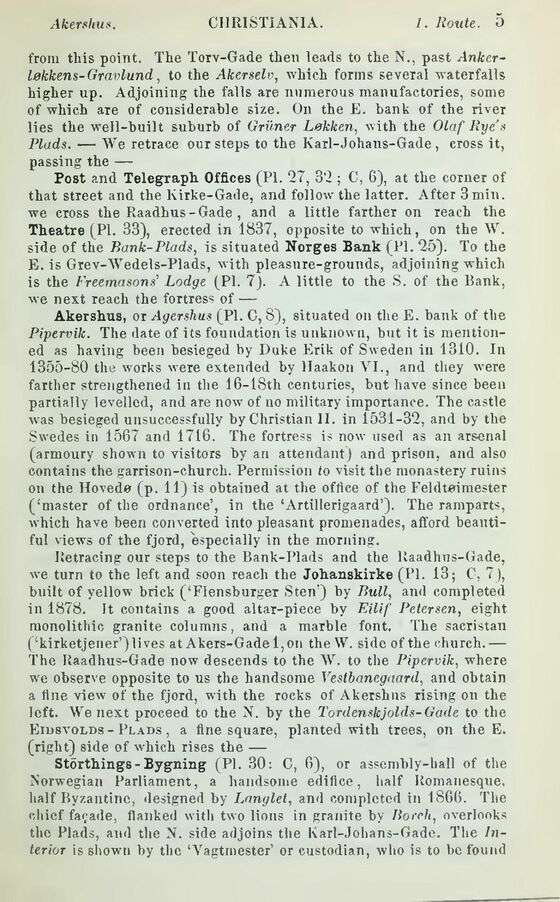
Full resolution (JPEG) - On this page / på denna sida - Norway - Pages ...

<< prev. page << föreg. sida << >> nästa sida >> next page >>
Below is the raw OCR text
from the above scanned image.
Do you see an error? Proofread the page now!
Här nedan syns maskintolkade texten från faksimilbilden ovan.
Ser du något fel? Korrekturläs sidan nu!
This page has never been proofread. / Denna sida har aldrig korrekturlästs.
from tills point. The Torv-Gade then leads to the N., past
Anker-løkkens-Gravlund, to the Akerselv, which forms several waterfalls
higher up. Adjoining the falls are numerous manufactories, some
of which are of considerable size. On the E. bank of the river
lies the well-built suburb of Oriiner Løkken, with the Olaf Rye’s
Plads. — We retrace our steps to the Karl-Johans-Gade , cross it,
passing the —
Post and Telegraph Offices (PI. 27, 32 ; C, 6), at the corner of
that street and the Kirke-Gade, and follow the latter. After 3min.
we cross the Raadhus-Gade , and a little farther on reach the
Theatre (PI. 33), erected in 1837, opposite to which, on the W.
side of the Bank-Plads, is situated Norges Bank (PI. 25). To the
E. is Grev-Wedels-Plads, with pleasure-grounds, adjoining which
is the Freemasons’ Lodge (PI. 7). A little to the S. of the Bank,
we next reach the fortress of —
Akershus, or Agershus (Pl. C, 8), situated on the E. bank of the
Pipervik. The date of its foundation is unknown, but it is
mentioned as having been besieged by Duke Erik of Sweden in 1310. In
1355-80 the works were extended by llaakon VI., and they were
farther strengthened in the 16-lSth centuries, but have since been
partially levelled, and are now of no military importance. The castle
was besieged unsuccessfully by Christian II. in 1531-32, and by the
Swedes in 1567 and 1716. The fortress is now used as an arsenal
(armoury shown to visitors by an attendant) and prison, and also
contains the garrison-church. Permission to visit the monastery ruins
on the Hovede (p. 11) is obtained at the office of the Feldteimester
(‘master of the ordnance’, in the ‘Artillerigaard’). The ramparts,
which have been converted into pleasant promenades, afford
beautiful views of the fjord, especially in the morning.
Retracing our steps to the Bank-Plads and the Raadhus-Gade,
we turn to the left and soon reach the Johanskirke (PI. 13; C, 7),
built of yellow brick (‘Flensburger Sten’) by Bull, and completed
in 1878. It contains a good altar-piece by Eilif Petersen, eight
monolithic granite columns, and a marble font. The sacristan
(‘kirketjener’) lives at Akers-Gade l,on the W. side of the church.—
The Raadhus-Gade now descends to the W. to the Pipervik, where
we observe opposite to us the handsome Vestbanegaard, and obtain
a fine view of the fjord, with the rocks of Akershus rising on the
left. We next proceed to the N. by the Tordenskjolds-Gade to the
Eid8volds - Plads , a fine square, planted with trees, on the E.
(right) side of which rises the —
Storthings - Bygning (PI. 30: C, 6), or assembly-hall of the
Norwegian Parliament, a handsome edifice, half Romanesque,
half Byzantine, designed by Langlet, and completed in 1S66. The
chief facade, flanked with two lions in granite by Bosch, overlooks
the Plads, and the N. side adjoins the Karl-Johans-Gade. The
Interior is shown by the ‘Vagtmester’ or custodian, who is to be found
<< prev. page << föreg. sida << >> nästa sida >> next page >>